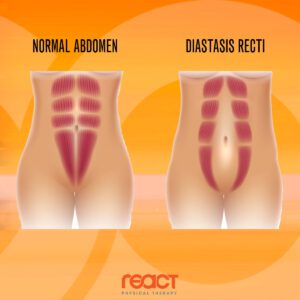Diastasis Rectus Abdominis (DRA)


Congrats on the birth of your baby (or babies)! Now that you have begun to settle into a new routine at home, maybe you have decided that you are ready to start exercising again (with doctor clearance). However, you were told at your 6-week follow-up appointment that you have diastasis rectus abdominis (DRA) and your doctor recommended physical therapy. But what exactly is DRA and why does it matter to you and your health?
Diastasis Rectus Abdominis, What is it?
To start, the rectus abdominis muscle is your “six-pack” muscle. Aside from aesthetics, its primary role is to flex (curl up) the trunk on a nonmoving pelvis like during a sit-up. It also helps to provide trunk stability during limb movement.
Diastasis rectus abdominis is a separation of the rectus abdominis muscle along the midline of your trunk. It commonly occurs during pregnancy due to the increased elasticity of the tissues. The biggest risk factors include multiparity (twins, triplets, or more), significant weight gain, high birth weight of baby, older maternal age, and multiple pregnancies. Of course, it’s always possible that there are other risk factors too. In general, within 1-8 days post-pregnancy, muscle recovery begins, but it tends to plateau following this time period. After this period, a separation greater than a 2 finger width is problematic.
Why does it matter?
This separation of the rectus abdominis muscle can cause a mechanical disadvantage of the abdominals due to lack of abdominal wall stiffness, leading to poor muscle coordination of the other abdominal muscles and muscle imbalance in neighboring back and pelvic girdle muscles.
Remember, your abs are important in trunk stability. So when you stand up, walk, lift, or carry your baby, your abs need to be strong to keep you from relying too heavily on those other muscles. Otherwise, it can potentially lead to low back pain, pelvic girdle pain or even pelvic floor dysfunction such as stress urinary incontinence.
What can I do about it?
Thankfully, this is something that can be addressed through physical therapy, even if you had your baby a couple of years ago! Physical therapy focuses on specific exercises aimed to help reduce the abdominal separation while improving muscle coordination and decreasing muscle imbalances.
Not sure if you have DRA? Here is a way to check:
● Lie on your back with your knees bent and feet flat on the ground.
● Place your fingers at your belly button parallel to your waistline.
● Perform a partial sit-up by bringing your ribcage towards your pelvis. Feel for the muscles on the sides of your fingers, making sure to move your fingers out of the way to allow the muscles to come together.
● The size of the separation is the number of fingers that fit in between this space.
 Still unsure?
Still unsure?
Check-in with your OB/GYN or your physical therapist!
* Sometimes DRA requires surgical intervention depending on the size of the separation (but you should still rehab those muscles after surgery!).